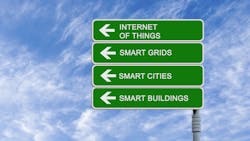The growth of distributed energy resources (DERs), clean energy, electric vehicles (EVs), and other new technology solutions will require a radical change in the way utility distribution grids are planned and operated. Granted, many U.S. electric utilities are already transforming their planning processes.
The Drivers
These drivers lead states to require utilities to analyze and build smart grids and post information regarding the capacity-bearing status of the utilities' substations and transmission facilities. All of these state drivers will require a radical change in the way utility distribution grids are planned and operated.
With growing levels of DER and EV penetration, utility distribution grids will need to be transformed to handle significant and intermittent two-way power flows and incorporate a wide range of new distribution automation, communication, and control technology. Utilities will also need to be able to monitor and manage varying loads and power flows down to the individual device level, such as EV charging and return of battery-stored energy.
A New Platform
Lisa Krueger, president of the U.S. Strategic Business Unit (SBU), responsible for the AES' U.S. generation units and its two U.S. utilities, Indianapolis Power & Light and Dayton Power & Light Co., stated that grid modernization, "…will transform the grid into a platform supporting customer choices, accelerating and enabling a low carbon future via easy integration of DERs and EVs, innovating in anticipation of customers' evolving needs because of rapid technological change, and enhancing reliability and resiliency for all connected customers.
Current utility distribution planning does not receive significant regulatory oversight from a planning perspective. Outcomes of the distribution system are reviewed and can affect the utility's financial performance through reliability performance standards. The lack of distribution planning oversight also precludes substantive public involvement. Yet distribution planning greatly impacts generation and transmission planning, where there is typically substantive public involvement. New state grid planning efforts include significant regulatory oversight with many states merging distribution planning into the integrated resource planning (IRP) process. States are also requiring utilities to afford opportunities for public involvement to allow broad input into distribution grid planning.
In assessing whether the electric grid is ready and primed for this new carbon-reducing energy structure, sadly the answer is, "No." For most utilities, the electric grid has been in service for many years and needs replacement. A 2015 report from the U.S. Department of Energy (DOE) concluded 70% of power transformers are 25 years of age or older, 60% of circuit breakers are 30 years or older, and 70% of transmission lines are 25 years or older. In the same report, the EIA stated, "Managing a grid with increasing amounts of customer-sited variable generation increases wear and tear on the distribution equipment required to maintain voltage and frequency within acceptable limits and to manage excessive heating of transformers during reverse power flow."
Justifying the Costs
Given that the grid needs major investment, an opportunity is created to redesign the grid to meet this new world of two-way power flows and DERs. The redesign will require substantial utility investments. While utilities are ready and willing to make these substantial investments, a key question is how will these costs be timely and fully recovered? Between 2012 and 2017, distribution investment increased 5.9% annually, to US$26.5 billion.
Grid modernization efforts will push utility distribution spending growth even higher, pressurizing utilities and state commissions to justify the increased costs of grid modernization. Substantial portions of these investments prepare for DERs not yet presently used and useful. This raises recovery issues in many states as facilities are built ahead of the need to accommodate future DERs and EV charging. For example, in 2018, the PUCs in Massachusetts and New Mexico rejected rate increases for advanced metering infrastructure (AMI) proposals because the costs were greater than the immediate customer benefits. However, New Mexico recently passed a law that allows a utility to file for cost recovery of a grid modernization plan.
Utilities and state commissions will need to expand the definition of benefits beyond the simple utility payback analysis traditionally used to justify utility investments. Because many distribution grid modernization efforts are an integral part of state laws and policies to address climate change, the economic analysis to justify grid modernization will need to include benefits including the economic impact of increased employment and investment, carbon reduction, and other external benefits.
About the Author
Mani Vadari
President and Founder
Dr. Mani Vadari is affiliate professor at University of Washington and founder and president of Modern Grid Solutions (MGS). Dr. Vadari delivers consulting and training services globally to smart grid companies seeking deep subject matter expertise in setting the business, technical and strategic direction to develop the next-generation electric/energy system. With over 30 years of experience, he has authored more than 100 industry papers, articles, and blogs, delivering business and technical solutions for transmission, distribution, and generation operations, wholesale markets, smart grid, cybersecurity/threat assessment, and smart cities. He has also published two books, Smart Grid Redefined: Transformation of the Electric Utility and Electric System Operations – Evolving to the Modern Grid.
